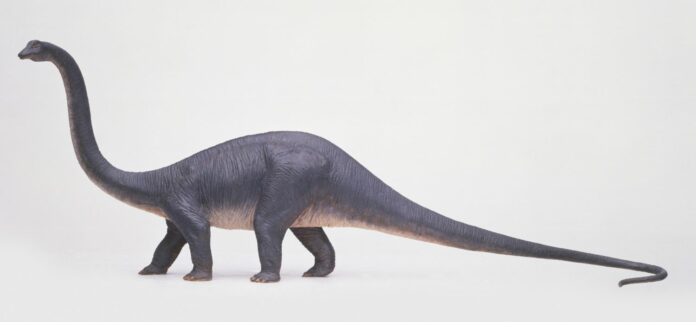Giant creatures that inhabited our planet millions of years ago are long extinct. However, they still occupy human minds: science fiction writers pen novels about them, filmmakers create movies, scientists search for evidence of their existence, and reconstruction specialists create 3D models of their skeletons and bodies.
The Giant Lizard from the Distant Past
The most famous prehistoric reptile is the Diplodocus. This herbivorous dinosaur lived during the late Jurassic period. According to scientists, medium-sized individuals reached heights of 25-27 meters. The most striking feature of its body was its massive neck, which supported a small head.
The hind limbs were longer than the front ones, causing the center of gravity to shift and the body to lean forward. Due to this specific structure, the Diplodocus could not escape from the predators of its time by running. Its defense was its tail, which the ancient giant used like a whip. The “miniature” dinosaur weighed between 20-25 tons. However, it was not the heaviest of ancient fauna.
The diet of the Diplodocus is not precisely known, as studies show very specific tooth structure. It is known that the favorite food of this Jurassic creature was plants. Presumably, these were fleshy tree leaves, low-growing ferns, or algae.
Interesting Facts about Diplodocus
- The name of the species comes from the Greek words “diplos” and “dokos,” which translates to “double beam” because the tip of its tail was bifurcated. This allowed the reptile to stand on its hind legs, using the “fifth limb” as support.
- The flexible tail of the herbivorous reptile consisted of a record number of vertebrae – 70. The neck had 15 segments, while the torso had only 10.
- The dinosaur’s brain was the size of a chicken egg. It was clearly not known for its intelligence.
- The giant’s heart, by conservative estimates, must have weighed over a ton; otherwise, it would not have been able to pump blood throughout its entire body.
- This is the only dinosaur species with nostrils located close to the eyes. Most likely, there was only one respiratory opening on its snout.
- The teeth of these long-necked Jurassic lizards resembled pointed pegs and were concentrated at the front of the jaw, where it was easier to strip leaves from trees.
- Diplodocuses are thought to have lived in the western part of North America (modern-day Colorado and Wyoming).
- Animals of this species had an enormous appetite, so an adult individual needed to consume over 1,000 kg of plants per day.
- Prehistoric herbivores solved digestive problems simply: to clean their stomachs, they ate small to medium-sized stones.
- It is likely that these reptiles were good swimmers and could stay underwater for extended periods.
- Diplodocus parents did not care for their young. Males were involved only in mating, while the females’ maternal instinct extended only to laying eggs.
- The largest number of found fossils are from this particular species of prehistoric lizards. The first of these were discovered in 1877.
The exact reason for the extinction of this species remains unknown to scientists. The most plausible hypotheses include climate changes, a sharp reduction in the food base, or the emergence of new, more advanced predators. To ensure that descendants do not forget about the giants of the Jurassic period, steel magnate Andrew Carnegie gifted full-size casts of their skeletons to major museums around the world.
